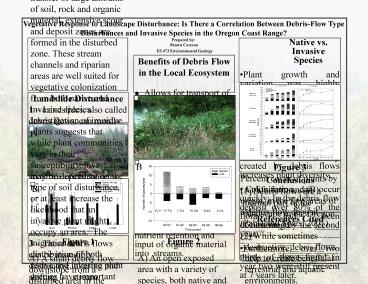Landslide Disturbance
Title: Landslide Disturbance
1
Abstract The Willamette Basin of western Oregon
is associated with a wide variety of geomorphic
and anthropogenic disturbances in riparian zones.
These processes include timber harvest,
cultivation, flooding, and mass wasting
(landslides and debris flows). Riparian areas
are particularly vulnerable to habitat
disturbance. Because debris-flows cause transfer
of large amounts of soil, rock and organic
material, extensive scour and deposit zones are
formed in the disturbed zone. These stream
channels and riparian areas are well suited for
vegetative colonization from both native and
invasive species. Investigation of invasive
plants suggests that while plant communities vary
in their susceptibility, invasion may be
dependent on the type of soil disturbance, or at
least increase the likelihood that an invasive
plant might occupy an area. The migration and
distribution of both native and invasive plant
species have important ecological implications
for river restoration and regional land
management strategies.
- Native vs. Invasive Species
- Plant growth and variation was highly influenced
by the composition of the deposit. - Early colonizers also had a profound effect on
local plant progression. - Substrate variability created by debris flows
increases plant diversity. - Colonization can occur quickly. In the debris
flow deposit over 80 of the flora had been
documented by the second year. - Furthermore, over two thirds of those found in
year two were still present at 7 years later. - Native species did well at colonization and
competing as long as invasives were not able to
colonize before natives could become established
(Pabst and Spies, 2001).
ES 473 Environmental Geology
- Benefits of Debris Flow in the Local Ecosystem
- Allows for transport of seeds and rhizomes
downstream. - Sediment and woody debris in stream channels
affect aquatic habitat. - They create an array of new surfaces for future
plant colonization. - The developing plants affect stream and
riparian ecosystems by providing shade,
increasing nutrient retention and input of
organic material into streams.
Landslide Disturbance 1 Landslides, also called
debris flows, can rapidly change the landscape of
riparian zones. 2 The sudden movement of
debris and water can scour the upper slope of all
its soil, forming a heterogeneous deposit of
organic debris, rocks, and sediment (Swanson
et al., 1987). 3 These debris flows can be
incredibly destructive, altering and shifting
stream channels, changing a streams gradient
and destroying roads, bridges and homes
(Benda, 1990).
A
A
B
Figure 3 Percent cover of plants by (A) life form
and (B) origin, in the five areas of a debris
flow deposit (Pabst and Spies, 2001).
- Conclusions
- (1) Debris flows are a normal part of the
landscape in the Oregon Coast range. - (2) While sometimes destructive, debris flows
help to create beneficial terrestrial and aquatic
environments. - Newly exposed substrates provide open light
areas and exposed soils that allow for increased
plant diversity (Pabst and Spies, 2001). - Initial colonizers and their perseverance were
key in plant community development. - Invasive species in this study only became
dominant if established before native species.
The largest benefit was to invasives with early
growing seasons which could become established
before native plants.
B
References Cited Benda, L., 1990, The Influence
of Debris Flows on Channels and Valley Floors in
the Oregon Coast Range, U.S.A. Earth Surface
Processes and Landforms, v. 15, p 457-466 ODA
Plant Division, Noxious Weed Control,
Oregon.gov. 11 Feb 2008. 27 May 2008.
http//www.obce.state.or.us/ODA/PLANT/WEEDS/profi
le_himalayanblackberry.shtml Pabst, R. J., T.
A., Spies, 2001, Ten Years of Vegetation
Succession on A Debris-Flow Deposit in Oregon
Journal of the American Water Resources
Association, v. 37, No 6, p. 1693-1708 Swanson,
F. J., L.E. Benda, S.H. Duncan, G.E. Grant W. F.
Megahan, L. M. Reid, and R. R. Zeimer, 1987.
Mass Failures and Other Processes of Sediment
Production in the Pacific Northwest Forest
Landscapes. Streamside management
Forestry-Fishery Interactions, University of
Washington, Seattle, Washington, p 9-38 "Tree
Damage, Timber Blowdown, and Forest Debris from
Winter Storm 2007." Oregon.gov. 14 Apr. 2008.
Oregon dept. of Forestry. 27 May 2008.
http//www.paroleboard.state.or.us/ODF/TimberBlow
down.shtml .
Figure 2 A) An open exposed area with a variety
of species, both native and invasive. B) Number
of species increased and decreased on a per-year
basis on the debris flow deposit. Annual rate of
turnover, using beta turnover (Wilson and Shmida,
1984), is shown as a percentage below each bar
Figure 1 A) A small debris flow downslope from a
disturbed area in the Oregon coast range. B)
Mean percent of ground cover 5 years after a
debris flow deposit. Error bars show standard
error. Soil in this figure are particles 2mm or
less (Pabst, R. Spies,T., 2001).































